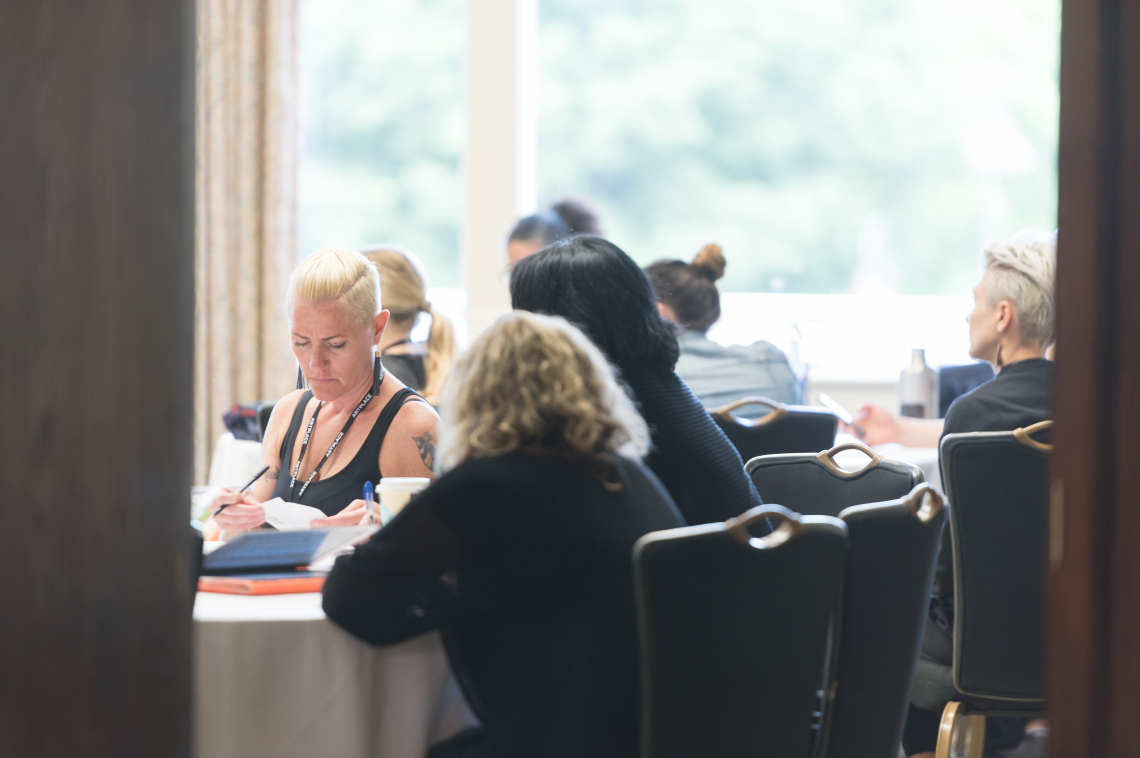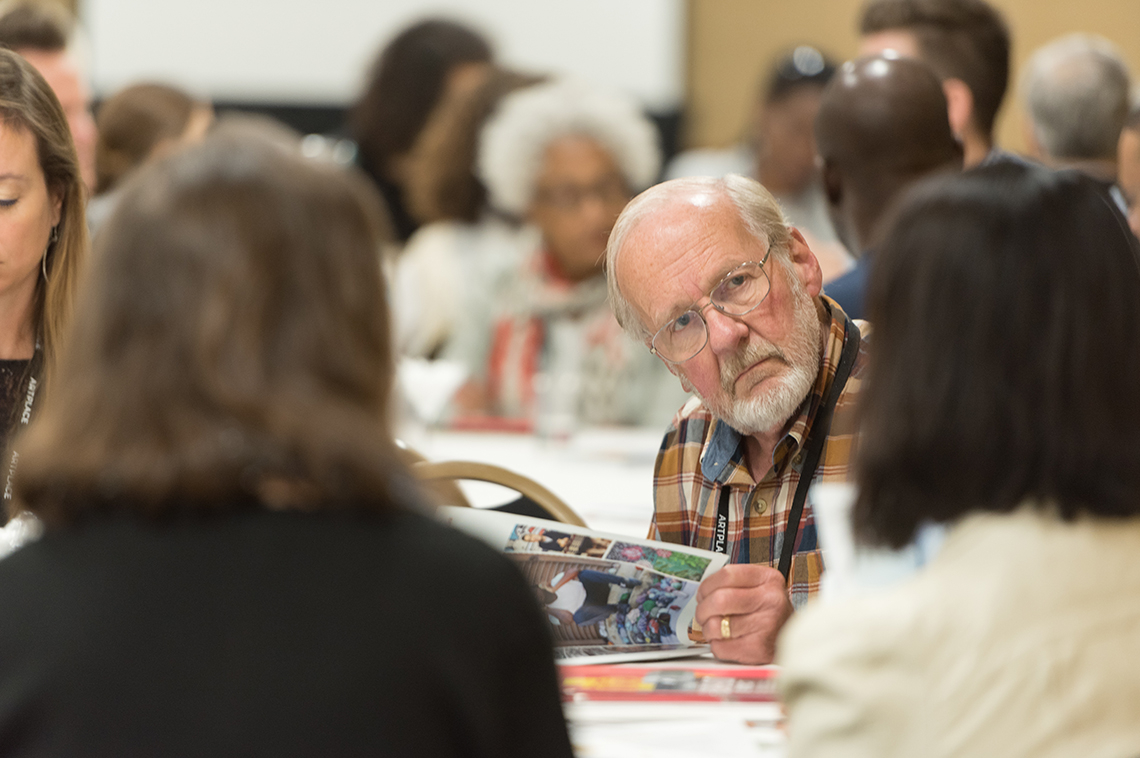

The session “Expanding Your Fundraising Repertoire” took place on May 23, 2018 at the ArtPlace 2018 Annual Summit in Louisville, Kentucky.
“You still can, and still should, be mission-driven—but business principles do apply.”
This was how Sarah Allan, Program Director of the Center for Great Neighborhoods in Covington, Kentucky, framed the workshop “Expanding Your Fundraising Repertoire,” which covered the myriad sources of funding available for creative placemaking work.
Allan was joined by Christa Drew, Principal of DAISA Enterprises; John Davis, then Executive Director of Lanesboro Arts in Minnesota (now a 2018 Bush Fellow); and Bob Reeder, Program Director of Rural LISC. Each spoke about finding support for a creative placemaking project they were involved with, then Drew introduced a group conversation about funding successes and challenges.
Drew kicked off the case studies with the story of the Hellmann Creative Center, the 14,000-square-foot historic lumber mill that her organization bought through a state auction for $35,000 and refurbished to house the Center for Great Neighborhoods’ offices; eight affordable artist studios; and over 3,000 square feet of public event space.
She laid out the following common funding sources for such capital purchases:
- Capital campaign
- Crowdfunding
- Grants
- Tax credits (including state and federal historic tax credits)
- Selling assets
- Permanent / long-term debt
- Short-term debt
- State bond financing
- Direct public offering
- Adverse possession (similar to “squatters rights”)
- Subscription (e.g., community members buy a year’s worth of performance tickets in advance)
She then offered some lessons from her organization’s own purchasing experience:
- “Frame the project, tie it to your mission, devise a funding strategy.”
- Some lenders will provide a grant and a loan at the same time
- Many local banks have a community investment requirement; some corporate banks will also make such loans
- Don’t think borrowing money will reflect poorly on you: making timely loan and interest payments is seen as a positive part of an organization’s cash flow and management
Davis spoke about his organization’s efforts to create the Lanesboro Arts Campus, which involved a “community-engaged vision plan” to repurpose two historic buildings into gallery, theater, and artist residency space, and install artist-made wayfinding signage throughout the campus area. Davis explained how Lanesboro Arts worked with historic preservation entities and a local livestock auction to raise the project’s profile. Another key partner was the area high school.
“We asked the school not, ‘Do you want to support this arts campus?’” Davis said, “but, ‘Do you want a football team in 10 years?’ Arts are a cornerstone of population growth; a key part of getting families to move to a community.” According to Davis, framing the question this way was key to the Arts Campus’ success. In 2014, Lanesboro City Council declared their whole community an arts campus, and at one point, so many businesses opened in the town’s center that they held a single ribbon cutting for 10 new storefronts.
Reeder shared takeaways from his work to create an arts and culture program at Rural LISC. Through it, his organization has awarded 65 creative placemaking grants to projects in 94 cities or counties across the country, averaging $11,000 each. “So these are not huge grants, but they exposed those communities to fundraising language,” Reeder said.
He stressed that, especially as ArtPlace approaches its sunset in 2020, “one thing we have to do is change our approach. We have to do our research; begin the process of community engagement for more local sources of funding.”
“Never, ever use the term ‘creative placemaking’ when approaching a mayor or city council person!” Reeder said, perhaps only half joking. “We have to frame these projects properly, and the language matters a lot. Figure out what their language is. Go to their meetings and find out what they’re saying. USDA Rural Development funds creative placemaking projects—but not by that name!”
He also encouraged attendees to avoid self-exclusion: “Don’t only look for arts funding because you’re an artist at an arts organization.” He said that in addition to pillar funders like the National Endowment for the Arts and the National Endowment for the Humanities, the following entities can be good potential funding sources:
- The Economic Development Administration
- Institute of Museum and Library Services
- Local farm bureaus
- State and local arts councils
- Utility conglomerates
- Colleges and universities
- Hospitals
Reeder also recommended the RFP section of Foundation Center’s Philanthropy News Digest.
During the group discussion, the speakers and audience exchanged the following tips:
- Many (though not all) funders will allow grantees who are not registered nonprofits to apply for and receive funds through a fiscal sponsor. So if your group is not a 501(c)(3), don’t despair! Just make sure to discuss the possibility of using a fiscal pass-through with your potential supporters.
- Conversely, if you represent a grantmaker who wants to make your funding more available to unincorporated groups, consider retooling your “grants” into “contracts” that don’t require nonprofit status to receive them. An audience member mentioned that THRIVE, a program funded by Nashville’s Metro Arts, uses this model.
- If your community doesn’t have a land bank, a local community development corporation can act as one in certain real estate transactions.





